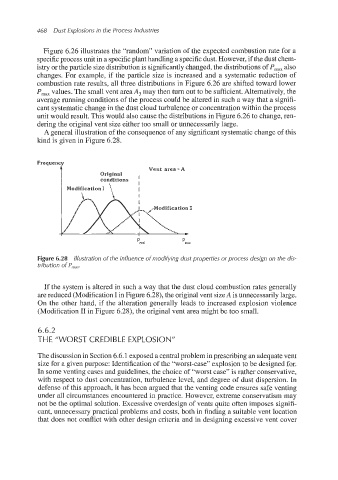Page 501 - Dust Explosions in the Process Industries
P. 501
468 Dust Explosions in the Process Industries
Figure 6.26 illustrates the “random” variation of the expected combustion rate for a
specificprocess unit in a specificplant handling a specificdust. However, if the dust chem-
istry or the particle size distributionis significantlychanged, the distributions of P,, also
changes. For example, if the particle size is increased and a systematic reduction of
combustion rate results, all three distributions in Figure 6.26 are shifted toward lower
P,,, values. The small vent areaA3may then turn out to be sufficient.Alternatively, the
average running conditions of the process could be altered in such a way that a signifi-
cant systematic change in the dust cloud turbulence or concentration within the process
unit would result. This would also cause the distributions in Figure 6.26 to change, ren-
dering the original vent size either too small or unnecessarily large.
A general illustrationof the consequence of any significant systematic change of this
kind is given in Figure 6.28.
Frequency
Vent area = A
Original I
conditions
I
Figure 6.28 Illustration of the influence of modifying dust properties or process design on the dis-
tribution of P,,,.
If the system is altered in such a way that the dust cloud combustion rates generally
are reduced (ModificationI in Figure 6.28), the original vent sizeA is unnecessarilylarge.
On the other hand, if the alteration generally leads to increased explosion violence
(Modification I1 in Figure 6.28), the original vent area might be too small.
6.6.2
THE ”WORST CREDIBLE EXPLOSION”
The discussionin Section 6.6.1 exposed a centralproblem in prescribing an adequatevent
size for a given purpose: Identification of the “worst-case” explosion to be designed for.
In some venting cases and guidelines,the choice of “worst case” is rather conservative,
with respect to dust concentration, turbulence level, and degree of dust dispersion. In
defense of this approach, it has been argued that the venting code ensures safe venting
under all circumstances encountered in practice. However, extreme conservatism may
not be the optimal solution. Excessive overdesign of vents quite often imposes signifi-
cant, unnecessary practical problems and costs, both in finding a suitable vent location
that does not conflict with other design criteria and in designing excessive vent cover

